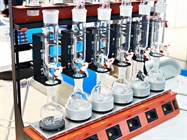
What is Solid Phase Extraction?
Sample purification and preparation is a crucial component that is completed prior to chromatographic analysis. One such technique of preparation is solid phase extraction or SPE. In SPE, one or more analytes are isolated from a sample by extracting and/or absorbing them onto a solid stationary phase and thereby simplifying the sample matrix and often improving the final analysis both qualitatively and quantitatively. This technique is quick, easy to complete, and has the ability to automated.
How Does SPE Work?
In solid phase extraction, the difference of affinity (or bonding of unlike compounds) between analytes and interferents in a liquid matrix is used to separate the target analyte from the undesired components. Typically, this will involve roughly five steps:
- 1. Pre-treat the sample. This includes (but does not limit) measures such as adjusting the pH and filtering.
- 2. Condition and equilibrate the cartridge with the solvent. This prepares the column for effective interactions with the analyte of interest. Much like the pre-treatment of the sample, the solvent used can vary on the type of the analyte you are isolating. The solvent should possess similar qualities as the sample.
- 3. Load the sample and apply a flow rate that is appropriate to maximize retention.
- 4. Use a wash solvent to remove any impurities that may be weakly bound compared to the strongly bound compounds of interest. Again, the wash is selected based on analyte as well as phase mechanism.
- 5. The final step is the elution step which recovers and collects the compound of interest by separating it from the sorbent.
What Are the Different Types of SPE?
Solid phase extraction typically falls into three main categories: adsorption, ion exchange, and mixed-mode.
Adsorption SPE is broken down into two phases, normal and reversed. In normal phase solid phase extraction, the separation is based on polarity and the compounds with the weakest polarity are eluted first and is typically used with analytes of moderate to high polarity. Conversely, reverse phase extraction is optimal for analytes with low to moderate polarity as this method elutes the most polar compounds first.
Like adsorption SPE, ion exchange SPE is also divided into two phases: cation and anion. Both methods will separate based on charge, but cation SPE is primarily for compounds of interest that are positively charged and will elute those analytes that are negatively charged first. The reverse is the case for anion SPE which elutes the positively charged analytes first.
In mixed-mode extraction, the abilities of reverse-phase SPE and ion exchange SPE are combined for an enhanced separation to enhance analyte retention and/or reduce contamination with impurities.
What Are Some Factors That Affect Solid Phase Extraction?
As discussed in the steps and types of SPE, there are several factors that can influence the degree of analyte recovery. This includes the pH and composition of the sample, solvents, and solutions used during extraction, as well as the polarity of the samples. The drying of the cartridge during the conditioning phase can also negatively affect retention as well as improper flow rates.
We're sorry, no matching articles were found. Please select different filter options and try your search again.
By submitting a product review you are not only sharing your experiences with others, but also gaining helpful insight from others in the research community.
Submit a Review